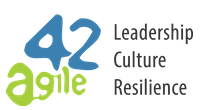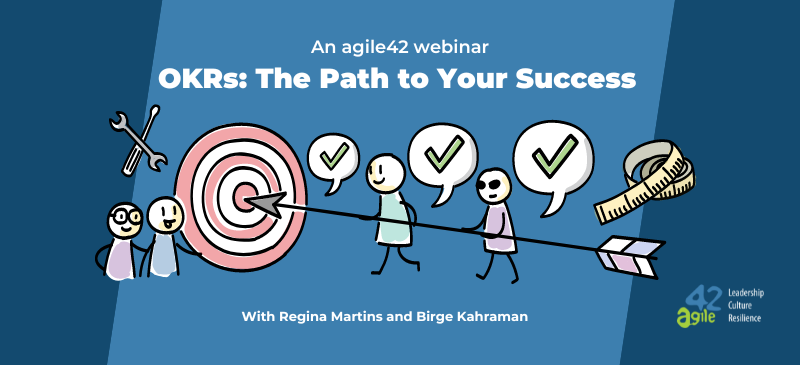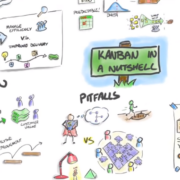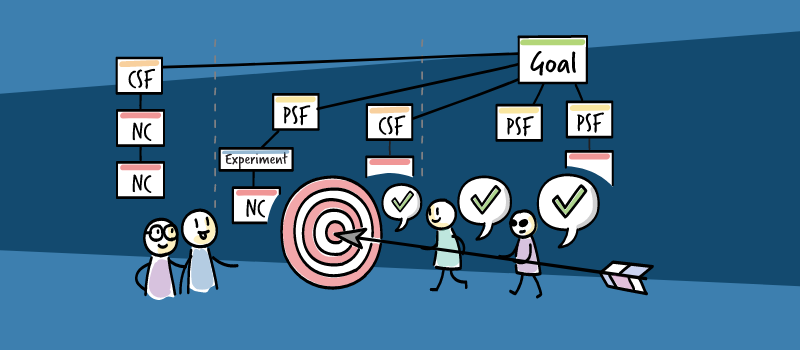Webinar | OKRs: The Path to Your Success
Goals are what drive us and create a path to our success. Many of us have a big goal in mind that guides us. But one big goal can be overwhelming: how do we decide on the smaller parts and day-to-day actions that will help us achieve it?
In this webinar, goal-setting experts Regina Martins and Birge Kahraman introduce you to the concept of OKRs, or Objectives and Key Results. They show you how to break your big, ambitious goals down into small, achievable, and clear steps. They outline how you can write action-orientated and strong objectives as well as impactful key results. Together, they explore how Agile teams can use OKRs, and how we can connect them to our business goals.
Learn how to successfully implement OKRs in our virtual training: Get your OKR certification now
Watch now | OKRs: The Path to Your Success
Regina Martins is based in Johannesburg, South Africa. She is an Agile trainer and coach who describes herself as a collaboration geek. She loves the role of facilitator as she enjoys helping teams and organizations work better together and find ways to overcome conflict.
Birge Elif Kahraman is from Istanbul, Turkey. She is currently based in Germany and has worked as an agile coach for many years. Kahraman has many passions (cats included), and always strives to create a trusting environment for teams to thrive. She also describes herself as an OKR enthusiast.
Martins and Kahraman both have extensive knowledge of OKRs and how they fit into an Agile environment. They spoke about OKRs at Scrum Alliances’ Global Scrum Gathering 2022 in Lisbon, where they titled their talk Like Carrots and Peas: Scrum and OKRs Complete Each Other. In this webinar, they dive into OKRs, and how we can use them effectively.
Recommended Reading: The ins and outs of OKRs
Nine key takeaways from the webinar
OKRs are more than just a goal-setting framework
There is a lot of misunderstanding around OKRs. For both Kahraman and Martins, OKRs are more than best described as a critical thinking framework. This idea is summarized by Ben Lamorte’s quote: “OKRs are a critical thinking framework and ongoing discipline that seeks to ensure employees work together, focusing their efforts to make measurable contributions that drive the company forward.” Martins comments that critical thinking is a challenging task but it is crucial in today’s world.
Connect Your OKRs to your vision and strategy
OKRs require bold decisions at a strategic level that define what the company needs to focus on. When companies start to implement OKRS, they always need to come back to their “why.” To make meaningful change, the company needs to have a vision and a strategy. And then communicate that to the rest of the team.
OKRs require companies to apply more focus and explore what is valuable to them. As a consequence of this, it may also inform the company on what they need to stop doing. Martins recommends that companies first define their long-term business priorities which are informed by the company vision and strategy. Once you have these, they will act as the north star or a guiding light for your OKRs. Kahraman likes to use The Pyramid of Clarity by Asana as it summarizes how OKRs are connected, from the top to the bottom, and how to align your projects to other business objectives.
Objectives should create a pull movement
A pull-based process is when teams decide on what to work on themselves based on their capacity and goals: they “pull” work in as they are ready for it. Work is not assigned or pushed onto them. This can have a significant impact on a team’s morale and how they work together.
“When you need to move from one state to another”, explains Martins, “it’s a forward motion so it needs to create a pull movement. People need to be inspired.”
In the context of Objectives and Key Results, an Objective is an inspiring statement that tells us simply which direction we want to go and creates a pull movement in teams. Objectives must also provide clear value. They should be broad enough that they do not restrict the contributions that teams can make toward achieving them.
Good key results are realistic (and can change)
Key Results (or KRs) tell us how we are going to reach our final destination, and they lie beneath the surface. They are not tasks, but rather a measurement of your progress toward your objectives. A good key result needs to be realistic, quantitative, and specific. You should also be able directly to influence your KRs, so they mustn’t be connected or dependent on things outside your control. They also need to be related to the objective and achieved within a quarter with only three to four KRs per objective. It is important that everyone in your team accepts the KRs as only then will everyone commit to them.
If it becomes apparent that your team will not achieve a Key Result, we should analyze them. Ask yourself why you haven’t achieved the result, advises Kahraman. “ Have you chosen the wrong initiatives or do you have some execution problems? Have the current conditions changed?” Once you have examined your existing KRs, can you decide when and how to pivot.
Initiatives are the bridge between objectives and key results
Initiatives are particular actions or projects undertaken to accomplish the defined objectives; they are your action plan. They are an important component of OKRs because they establish a clear relationship between the Objectives and the activities that must be taken in order to achieve them.
For example, if the KR is to reduce absenteeism by 25% in the next quarter, an initiative could be to launch a new benefits program or to implement flexible working conditions. Initiatives in OKRs are also specific, measurable, and time-bound, with clear ownership and accountability. The initiatives should not come from the top; they should be decided by the teams involved. As Kahraman says, “I see initiatives as the bridge between Objectives and Key Results.”
OKRs shouldn’t include all of your business activities
It is important to note that OKRs are not intended to include all of the company’s activities, and that Business As Usual (BAU) will carry on. If you struggle to balance BAU and OKRs, Kahraman recommends that you invest 70% to 80% of your time on OKRs and leave 20% for BAU activities or anything critical that might pop up.
OKRs and Scrum complete each other
Many people think OKRs and Scrum are mutually exclusive, but we believe they actually complete one another. OKRs are about change, and the iterative nature of OKRs can support this change. OKRs follow a quarterly cycle that allows for adaptations to be made, which include a planning period, an execution and check-in period, as well as a review period.
“The iterative nature of OKRS maps so beautifully to the Scrum Framework,” explains Martins. The OKR structure helps to granularize the strategic goals at a team level, and teams can realize those goals by deciding the “what and how” in each Sprint. In some cases, Product Goals and Sprint Goals can be matched with Objectives and Key Results. Sprint Goals will ensure that a development team is making progress toward the Objectives established in the OKRs, while OKRs can give a broader perspective and ensure that the team’s work is aligned with the organization’s overall strategy. Within the OKR cycle, the Scrum events can provide the meetings and rituals to get this done. Scrum values fit into the OKR framework as they allow for open communication, collaboration, and trust.
OKRs can empower Agile teams
OKRs aren’t supposed to be used as a management tool. Rather, they should be outcome-based and empower teams. “OKRs are a breeding ground for agility as they are both iterative and incremental,” says Kahraman. Large organizations have many different departments and projects, and each one has a role to play. OKRs serve to connect the whole organization, not just those in the tech space. As Kahraman explains, “OKRs help to connect the higher level goals to your teams and your day-to-day operations.”
If Objectives are broad and aspirational enough, teams will align around them and set up their own KRs. Different teams can have different ways of contributing, and OKRs allow them to be more creative and develop a greater sense of ownership. In this instance, we can see how Agile leadership can support the successful implementation of OKRs.
Recommended online course: Agile Leadership Foundations
OKRs can flourish in an Agile environment
An Agile environment promotes collaboration, innovation, continuous improvement, and the freedom to experiment. In every OKR cycle, you can build on what you have already achieved and you can decide to change direction based on feedback, as long as you are moving forward, improving, and experimenting. For this to happen, companies should create a safe-to-fail environment for teams to fail fast and learn even faster. An Agile environment can help teams and individuals to harness the true power of OKRs.
John Doerr reminds us that: “OKRs are not a silver bullet. They cannot substitute for sound judgment, strong leadership, or creative workplace culture. But if those fundamentals are in place, OKRs can guide you to the mountaintop.”
Want a snapshot of your organization’s leadership strengths? Try our free Leadership assessment









